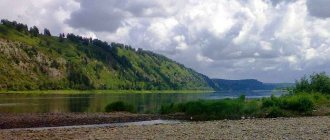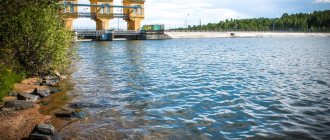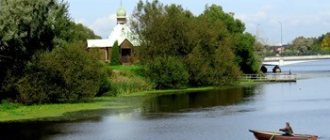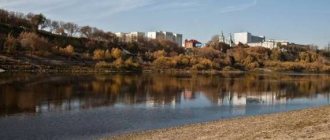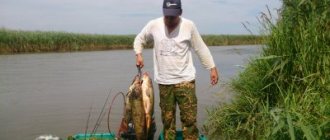The river is 603 kilometers long, flowing through the territory of the Sverdlovsk and Tyumen regions. Within the Sverdlovsk region it is suitable for tourist rafting and is interesting for its rocks and caves.
The Pyshma River originates from a small swampy lake called Klyuchi near the cities of Verkhnyaya Pyshma and Yekaterinburg. River basin: Tura – Tobol – Irtysh – Ob – Kara Sea. The area of the river basin is 19,700 km2. This is the eighth longest river in the Sverdlovsk region.
What does the name of the river mean?
Let's look into the book of the famous Ural linguist A.K. Matveev “Geographical names of the Sverdlovsk region”:
“In the “Book of the Big Drawing” of 1627 it appears as the “Pysh River”, but already in one document of 1629 it was called Pyshma three times, so in the “Book of the Big Drawing” there is apparently an error. This toponym, which is very difficult to explain, has been unlucky from the very beginning: the famous Johann von Stralenberg, a captive Swede who lived in Siberia for a long time and wrote a large study about it, talking about the writings on Pyshma, put forward the assumption that Pyshma is from the Russian word ... letter. Historian G.F. Miller noted in this regard that there are no writings on Pyshma, and the word is not Russian, but Tatar, which the Tatars themselves pronounce Pishni.
Later studies added almost nothing. Among local historians, the opinion has spread that Pyshma translated from Tatar means “Calm” (there is a Tatar word poshmas - “unhurried”, “slow”), but this is a very dubious version. It is also assumed that Pyshma goes back to Pyshva, where va means “water” from the Komi-Permyak language, but even this cannot be proven.
Most likely, the toponym Pyshma penetrated into the Tatar language from some more ancient pre-Turkic language. Since the immediate predecessors of the Turkic peoples on the territory of the Trans-Urals were, apparently, the Ob Ugrians, the explanation for this mysterious name must be sought primarily in the Mansi and Khanty languages. But the Mansi lived closer to the Urals, and in the Mansi language there are no obvious correspondences to the hydronym Pyshma, but in the Khanty language there is a very interesting adjective pysyng - a parallel word to emyng - “saint”. Since the final ng is often conveyed to Russian m, one might think that pysyng was perceived as pysym. Mutual transitions s–w are very widespread. The names of the sources of Pyshma are also very remarkable: the right one is Pyshma itself, and the left one is the Molebka River, which originates in the Molebnoye swamp. Thus, the version that Pyshma is “Holy (river, water)” begins to acquire more or less serious grounds.”
Features of the Pyshma River
The Beloyarsk reservoir was created on the river, intended for the needs of the Beloyarsk NPP. In the first years of operation, radioactive waste entered the Pyshma River basin. However, this had almost no effect on the Beloyarsk Reservoir, in particular, the fish there are completely normal and do not have an elevated background. There are also several small ponds.
The largest settlements on the banks of the Pyshma River: Verkhnyaya Pyshma, Berezovsky, Staropyshminsk, Zarechny, Beloyarsky, Sukhoi Log, Kamyshlov, Pyshma, Talitsa. Due to enterprises and other human activities, the river is heavily polluted.
In 1745, in the upper reaches of the Pyshma, peasant Erofey Markov from the village of Shartash discovered what is believed to be the first gold in Russia (although not so long ago local historians established that the first gold was discovered on the Iset River - at the Shilovo-Isetsky mine).
On the Pyshma River near the village of Stanovaya, a dredge still operates today to extract gold. According to local historian Boris Maidanik, this dredge was manufactured in the city of Votkinsk; it has been operating on the Pyshma River since 1934. Over time, having completely worked out the upper reaches of the river, the dredge reached the railway bridge near the Berezit station. The three-story dredge, naturally, could not pass under it. To allow it to pass, they decided to temporarily raise the bridge. For this purpose, four vertical trusses with lifting winches were built nearby. A dam was built below the bridge, causing the river to overflow and form a pond. And so, on July 9, 1962, the bridge was raised and the dredge passed downstream. The whole operation took 2 hours 20 minutes. This was the first time this had been done in the USSR.
Preparation for raising the railway bridge across Pyshma for the passage of the dredge.
In the past, Old Believers hid in some places on the Pyshma River. According to researcher S.A. Beloborodov, after the authorities destroyed the Kazan monastery on Shartash, 15 versts from the village of Beloyarsky, Yekaterinburg district, Mother Faina settled on the left bank of the Pyshma (in the world - Marfa Grigorievna Chuvakova). It was possible to get to the settlement only through a single bridge, which was dismantled in case of danger. Bishop Gennady of Perm, one of the most significant figures among the Old Believers of the Belokrinitsky Consent (the so-called “Austrians”), often stayed with Mother Faina. The name of Gennady (Grigory Vasilyevich Belyaev) is associated with a significant increase in the activities of representatives of the Belokrinitsky Church in the Urals and Siberia. He held the rank of Bishop of Perm from 1857 to 1862. Gennady was arrested several times, he was in prisons and prison companies, but he did not renounce his faith.
In the spring, tourist rafting takes place along the Pyshma River. Although there are few tourists here. Rafting can start in Beloyarskoye or from Belokamenny, and end in Sukhoi Log or Kuryakh. These places are also interesting for hiking.
The main highlight of the river is the coastal rocks. Fossils are found on them in places.
The first rocks downstream are found in the village of Staropyshminsk. For the rare plants growing on them, they received the status of a natural monument of the Sverdlovsk region.
Some rocks have their own names: the Diviy (or Divya Gora) stones, Kovrizhka, Bryukhanov, Devil's Chair, Three Sisters. Others are nameless.
The Divy Stone is located on the left bank of the river near the village of Znamenskoye. These are the remains of an ancient volcano. At the base of the rock you can see tuffs and jaspers of purple and red color. At the end of July - beginning of August, the student song festival “Znamenka” is held here.
And in front of Sukhoi Log, a small river Shata flows into the right. The Shata (or Shatsky) waterfall of the same name was formed on it. You need to see it in the spring, because in summer it is only a small trickle of water.
The most picturesque rocks are within the city of Sukhoi Log. They have many caves.
The most famous of these caves is named after the mining engineer F.Yu. Gebauer, who studied it in the 1870s. In the cave he discovered traces of an ancient man.
Downstream there are also a number of rocks. And in front of the village of Kurya, hidden behind the forest, is the Devil’s Chair rock, named for its characteristic shape. Finding the rock is not easy, since in recent years it has been heavily overgrown with forest.
There is a stone rotunda on the Three Sisters rock. According to legend, three sisters, having fallen in love with one young man, threw themselves off a cliff into the river so as not to build their happiness on the misfortune of their sisters. On the mountain there is the resort-sanatorium “Kuryi”, which has long been famous for its mineral waters.
V.A. Vesnovsky wrote about these places in his “Guide to the Resorts of the Urals” in 1902:
“Here the Pyshma River has cut through a mountain ridge, spurs of the Ural ridge, and emerges into the open space from rocky, rocky shores. Higher up from the sources, the banks of Pyshma amaze with their bizarre outlines and stretch like a continuous rocky ridge. Some rocks rise up several tens of fathoms. In some places, such a steep barrier stretches along the shore for several fathoms, presenting an original spectacle... The area occupied by the resort is one of the most beautiful places in the vicinity of the Urals. Nature has given everything here to live calmly and happily in its bosom for several summer weeks, taking a break from the usual squabbles and city prose, and breathing in the clean, healthy mountain air, full of ozone. The main beauty of the resort is the rocks. They are sometimes brown, sometimes brown, but majestically proud, rising now on the right and now on the left bank of the river. Pyshma. At their foot the river spreads like a snake, silvering with its smooth mirror surface. Masses of brown stone protrude like humps above the water, piled on top of each other, forming figures of bizarre shape. Where possible, pine trees have strengthened along their ridges and slopes and stand proudly in their evergreen attire. Right there, like an orphan, the birch tree got lost, lowering its curly branches to the ground. All these rocks are masses of limestone of a brownish-dirty color, speckled with rusty spots and covered with moss.”
Pyshma - a river near Tyumen
Published by: zampolit, 12/18/2014, 06:18, Travel routes, 8 521, 0
Pyshma
flows from Lake Klyuchi in the vicinity of the city of Verkhnyaya Pyshma (Sverdlovsk region) and flows into the Tura about 4 kilometers below the village of Sozonova.
The length of Pyshma is 614 kilometers, including 150 kilometers within the Tyumen region. Unlike Tura, Pyshma is very winding, replete with riffles and whirlpools. Its width is from 30 to 100 meters, depth from 0.7 to 8 meters. In the channel there are individual islands and entire groups of them. The Pyshma catchment area reaches 19,700 sq. km. Three reservoirs were built on Pyshma within the Sverdlovsk region: near the village of Beloyarsky, the city of Sukhoi Log, and 8 km below the city of Kamyshlov. Near Tyumen, tributaries flow into Pyshma from the left - Karmak, Ushakovka, Duvan, from the right - Chaplyk, Balda, Bardyanka, Chernaya Rechka , Scurvy, Hag, Boganda, Black. They are longer and richer than the tributaries of the Tura. Pyshma
usually disappears around mid-April, on average April 13th. The earliest date for the start of ice drift is March 30, 195, the latest is April 30, 1914. On the winding and narrow Pyshma, the ice often melts without moving. The highest level of rise in Pyshma occurs at the end of April - beginning of May. During the day, the water rises by 10-50 centimeters, gradually reaching a maximum level that lasts 1-5 days, after which the flood begins to decline.
During a flood, water quickly enters the river valley and floods the floodplain.
Through streams, ditches, and oxbow lakes, water first penetrates into the lowest places, then floods the middle part of it, and lastly, the so-called riverbed shaft, the highest place of the floodplain. However, the release of water onto the floodplain does not happen every year, but only during a major flood. The floodplain is under water for 20-30 days, the water depth on the floodplain reaches 2-4
meters.
In spring, Pyshma usually floods its entire valley - 1.5-2
km (in the lower reaches). At this time, the tributaries flow backwards - from the bottom up, the water fills all the floodplain lakes, penetrates through the swampy lowlands far into the depths of the Pripyshma forests. After the flood, the water gradually subsides, and in late July-early August the summer-autumn low water level sets in. This is the name given to the lowest level in the river. However, summer rain floods are often observed at this time, although they are usually much smaller than spring ones.
In autumn the rivers begin to freeze.
Small rivers and streams freeze from their banks, where banks form and increase every day. Sections of rivers with a quiet flow - reaches - are the first to freeze. On Pyshma, small pieces of ice, the so-called “fat”, first form. When there is a lot of it, “shuga” flows down the river - autumn ice drift. It doesn’t happen to Pyshma every year. Gradually the slush freezes and freezes up. On Pyshma near Bogandinsky, freeze-up occurs on average on November 9, the earliest date is October 20, and the latest is November 30. The river is under ice for an average of 165 days. By the end of March and beginning of April, the ice reaches its greatest thickness - 50-70
cm, but it depends on the snow content, severity and duration of winter and therefore varies in different years.
The shallow tributaries of the Pyshma often freeze to the bottom. In severe frosts, the ice cracks, water comes up and freezes, forming ice dams. Here the ice thickness reaches 1.5-2
meters. In winter, rivers switch to groundwater feeding, so their level decreases, reaching a minimum in December-January (winter low water). The ice turns out to be torn away from the water and collapses and settles under its own weight. So, in the fall of 1984, the Pyshma floodplain before the freeze-up was flooded with water from the autumn flood. When ice about 20 cm thick formed, the water left. The ice settled, and vast areas of the floodplain were covered with a thick ice shell, which collapsed in the river bed to a height of 1.5-2 meters. A similar phenomenon was observed in the winter of 1986/87. Pyshma within the Tyumen region is intensively used as a source of drinking water. A lot of it goes to technical and agricultural needs. Many agricultural joint-stock companies in the region have irrigated plots where vegetables and fodder crops are grown.
Even during the war years, Pyshma was used in the spring to float local timber to the timber exchange and sleeper cutting plant in Vinzily, but during the 80-90s of the 20th century it became fairly shallow.
In pre-revolutionary times, there were several water mills on Pyshma, which were destroyed when steam and electric mills appeared. One place near Vinzili reminds of them; it is still called the Mill. There are remains of a dam there. 20 kilometers from Tyumen the Chervishevsky tract crosses the Pyshma River. Here it flows in a wide – up to 4 km – valley, but the river itself is narrow: at low water it is no wider than 30-40
meters.
The average depth is about 2
meters. Pyshma flows slowly and fully justifies its name, derived from the Tatar word “poshmas” - unhurried, slow, calm. It often changes its channel, washing a new one in the sandy soil at the bends. For this reason, there are many oxbow lakes of different sizes and ages in the floodplain. The most ancient ones have long been turned into swamps, the banks are densely overgrown with willows and grass. This created good conditions for numerous waterfowl to live in the Pyshma floodplain. Along the river from the village of Onokhino to the border with the Sverdlovsk region there were the Chervishevsky and Uspensky complex reserves. Since 1995, the Chervishevsky reserve has been closed. On the left bank of the Pyshma near the bridge there was a pioneer camp “Chaika”. Here, in 1914, a training and experimental site was organized at the Chervishevsky rural 2-grade school. Working on the site, students received basic knowledge of agriculture, and also carried out demonstration experiments in the cultivation of agricultural services. The site occupied an area of 13 acres. In 1922, the provincial land authorities created a state farm-agricultural center here for experimental and demonstrative purposes, where new agricultural machines and methods of cultivating crops on the sandy and peat soils that were on the site were demonstrated to the peasants of the surrounding villages. To the right of the road there is the “Setka” gardening and dacha partnership and the “Pyshma” fish farm, which breeds fish in ponds with mineral water of the same composition as at the Taraskul well. It was built in 1975. A system of fish ponds has been created on the banks of the Pyshma, two wells supply warm underground water. It was once the country's first geothermal fish farm. From here, fry of carp and other fish are transported to the lakes of our and neighboring regions. The first bridge across Pyshma in this place was built in 1912. Before this, we crossed on a ferry that could accommodate 4 carts, or took a detour to the Onokhinsky bridge. In 1971, when the highway was reconstructed, a reliable reinforced concrete bridge was built on Pyshma. In July 1918, there were fierce battles along Pyshma: detachments of Red Guards defended Tyumen from the White Czechs and White Guards advancing from Kurgan. The fighting went on for almost two weeks. Only under the pressure of superior enemy forces on July 19 did the red detachments leave for the Urals.
- 80
